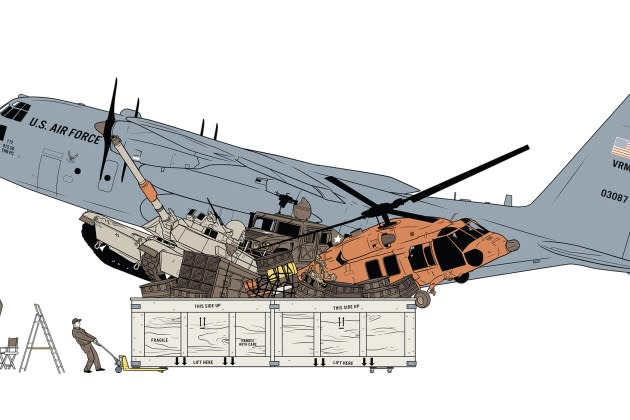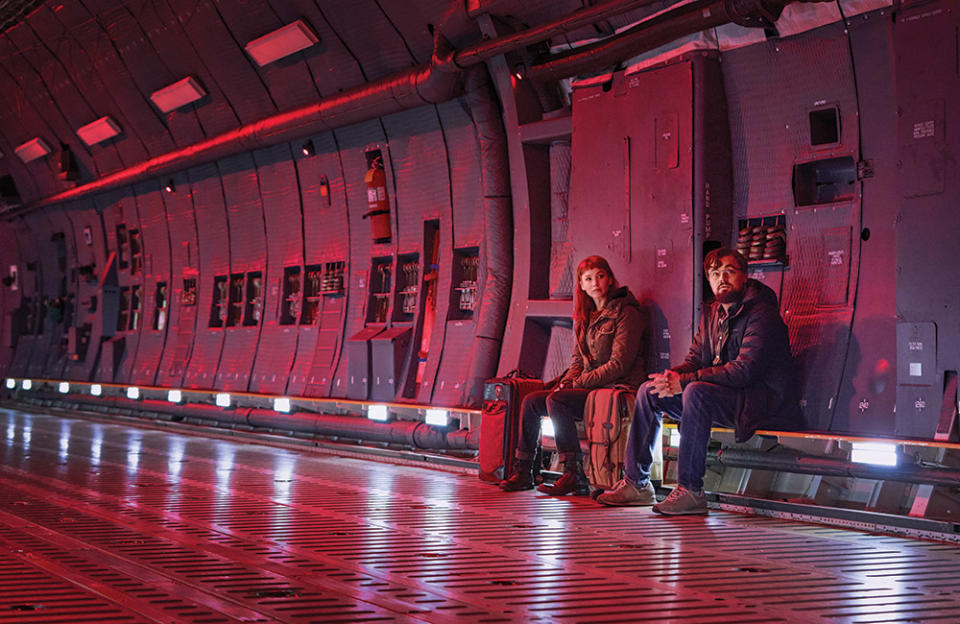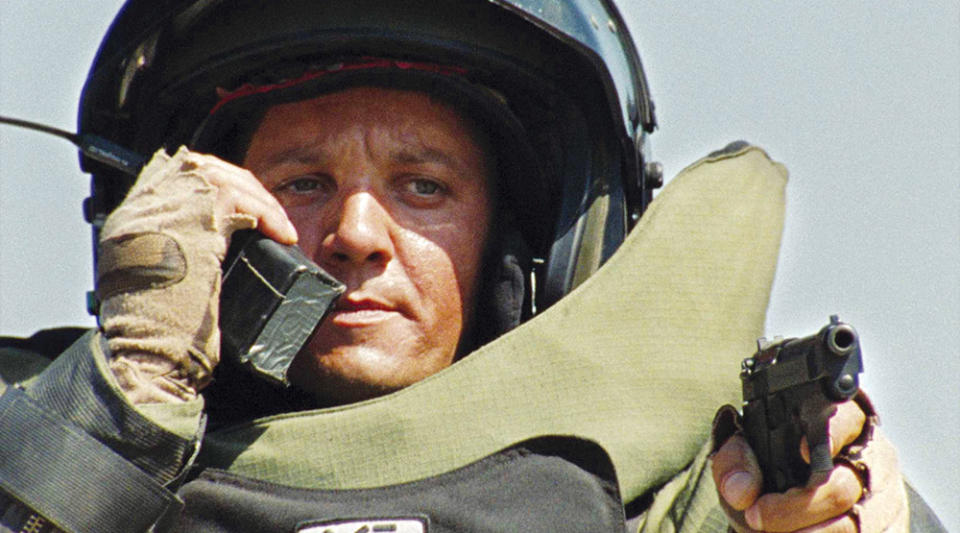Need a Black Hawk on Set by Friday? Call This Couple

When producer Jeff Waxman requires military hardware and tactical gear for his movies, he calls Adam and Cat Stone, a long-married couple operating out of the Manhattan Beach home they share with their three kids. In recent years, they’ve secured body armor and motorcycles for John Wick: Chapter 3 — Parabellum, as well as a C-130 military transport plane and an air base for Don’t Look Up. For Waxman’s still-to-be-slated feature Our Man From Jersey, a spy thriller starring Mark Wahlberg and Halle Berry, the pair was tasked with delivering Range Rovers in both left-hand and right-hand drive on deadline for action sequences in multiple international territories. “It’s always a mess when I’m not dealing with them,” the producer says.
The Stones are among the leading independent product-placement specialists in Hollywood, and during a recent lunch on the terrace at the Polo Lounge, they spoke of how they’ve cornered enough of the market in what they term the “tactical space” that they’ve established a dedicated unit within their firm, Stone Management, called Modern Warfare to address it. By Adam’s reckoning, The Hurt Locker, winner of the best picture Oscar in 2010, was “our entrée into this; a lottery ticket.” Since then, they’ve landed gear from top tactical-sector companies like AGM and London Bridge Trading in The Gray Man and Zero Dark Thirty, respectively, and served as matchmaker for defense giant Lockheed Martin to consult with director James Gray and his production team on his space-exploration epic Ad Astra. The couple’s next projects include the upcoming special ops thriller Land of Bad, starring Russell Crowe and Liam Hemsworth, and the military-cult movie Tin Soldier, featuring Jamie Foxx and Robert De Niro. (They won’t disclose the brands they’re working with prior to the films’ release.)
More from The Hollywood Reporter
'Yellowstone' Effect: Streamers Eager to Hitch a Ride West on the Back of Hit Series
Jefferson White, Adeline Rudolph Join Hellboy Movie 'The Crooked Man'
The Stones met in 1999, on the Miami set of an indie skydiving thriller, Cutaway. “It was an AFM special,” explains Adam, referring to the American Film Market, which is known as a clearinghouse for lower-budget action fare. He was a producer on the Point Break-esque project, having earned a series of similar credits after graduating from USC film school and learning the business at fabled B-movie studio The Cannon Group. Cat, the “hot blonde” — Adam’s words — who’d been cast as co-star Dennis Rodman’s drug-smuggling girlfriend, became Adam’s wife two years later, leaving behind a busy print-modeling career in Europe. They briefly entertained the notion of raising a family while shooting around the world, itinerancy sustained by tax incentives, then decided a better plan would be to work together from home.
Given their backgrounds and relationships with merchandisers, ad hoc requests to consult on brand partnerships for productions soon turned into a lightbulb moment. “I looked at Cat,” explains Adam, “and I said, ‘We’re going to become real estate agents — but do it for the screen.’ “
The couple works on as many as 10 projects at once, aided by a small staff. Adam focuses on the production side, cultivating creatives and their financiers — the latter often keen to either trim shooting costs or bolster the marketing budget for the release. Meanwhile Cat, more at ease with ROIs and other metrics, is the brand whisperer, the one conspiring how to get a signature product from No. 5 to No. 2 in sales in its category during the next 36 months. As she explains, “Each one comes with a different brand weight. Some want to be in absolutely everything. Some are focused on a few key projects that are very important to them. Some have a favorite actor and they just want to chase everything that person is in.” (The Stones, who employ a script reader to vet for nascent collaborative opportunities — “not everybody has such early access to material,” Adam says — are typically paid on retainer by brands and on a per-project basis by productions.)
“It’s real practical,” Cat says of the logistical core of the job. “We’re going to help you get stuff.” Echoes Adam: “The most important part of our business is delivery. There’s a certain exigency with production that has to be met — and not everybody gets it. ‘I can get you x amount of Armani.’ Great. But if it isn’t there in time for the fittings, it’s a waste.” Cat again: “Also, can you get big things? Which require the right paperwork to arrive? Your Black Hawk [military helicopter] will be on set when you need it.”

Vetting is another consideration; no brand wants to become the wrong kind of meme. Just as alcohol companies can’t work with stars who’ve had DUIs and one country’s approved pharmaceutical is another territory’s illegal substance, in the defense realm, there’s the requirement to comply with International Traffic in Arms Regulations, which govern the export of military-related technologies.
101 Studios head David Glasser, who’s partnered with the Stones for two decades, most recently on Yellowstone and its offshoots for a variety of product needs, explains that “they really find the perfect marriage between a brand and a creator. When you’re working with someone like a Taylor Sheridan or an Antoine Fuqua, you have to be very specific in how you look for organic opportunities to do things — and you have to have a producorial skill in your mindset. If you asked me for their competition, I couldn’t tell you.” Cat says exercising restraint in onscreen placement is key, for clients as well as audiences: “It’s about what makes sense — what’s not atrocious. Nobody wants to cringe.”
For defense contractors and other military-oriented firms whose business models aren’t geared toward consumer demographics, appearing in productions is less about a potential sales bump than brand recognition within their insular, hypercompetitive milieus. “This is much more about bragging rights — ‘Everybody knows Hollywood chose us,’ ” explains Cat. Adds Adam: “There might ultimately be just a few thousand people that even understand, in some cases, what exactly that product is [shown onscreen]. But they all know who won the stakes.”
Gary Moore, a global brand manager for Dell Technologies, points to its Rugged line of laptops and tablets, which are acquired by government agencies and police forces. “We want to see them in appropriate scenes,” he says. The Stones have positioned them in a number of productions, including the Netflix actioner Extraction, about a black ops mercenary, and Epix’s CIA thriller Condor. In signing off on such decisions, Moore is mindful of the context. “I use the Jason Bourne series as an example,” he says. “Clearly Jason Bourne is an aggressive, somewhat violent character, but he is the protagonist and you’re rooting for him. [Vetting] is more art than process. I can read a script or look at a detailed synopsis.” (Todd Handelsman, a vp at the Stones’ firm, notes that client Fiji Water was cool with an off-label use of its bottle in 2022’s Bullet Train, given the circumstances: “It helps that the person putting the sleeping powder in it is Brad Pitt. I’ve learned that the not-OK-usage can be OK if it’s a big, A-list star.”)

Tony Mark, a seasoned production manager turned producer, is still amazed by what the Stones pulled off for him on The Hurt Locker. “I think it’s legitimate to say they performed miracles,” he says. “There was no way in the world on our small-budget film to think about getting a bomb-disposal robot. We were thinking about how to get the special effects department to make something that we could pass off. Adam and Cat thought we should try to get one. I was like, ‘Really? That’ll never happen.’ Then they convinced Northrop [Grumman] to allow us to use their latest iteration of a bomb disposal robot, and it cost us flying over and putting up their technicians. The level of production value that gave the film was invaluable. You simply understood that you were watching something that was genuine.”
Mark, who’s since gone on to work with the couple on CBS’ SEAL Team Six and TNT’s The Last Ship, adds that they then convinced bomb-suit manufacturer Med-Eng to provide multiple $75,000 protective suits for The Hurt Locker. “What brand was going to give you a suit where in the very first scene the actor dies in it?” (Some modifications were made to change the look of the apparatuses.) The Stones, who when pitching these firms on The Hurt Locker had yet to develop a track record on defense-oriented projects, say they convinced the clients through sheer persistence and concerted focus on how the products would be portrayed in context onscreen.

Paul Cabellon, who now heads communications for the satellite imaging firm BlackSky, was then the point person at Northrop Grumman. “I can’t imagine how difficult it is for Adam and Cat to navigate these waters,” he says. “It’s really hard to walk up to the defense industry and ask for stuff, because they don’t need [the exposure],” noting that the defense field operates on glacial time horizons and 10-digit government contracts. What’s more, while executives — typically former military officers who’ve pivoted to the private sector — may be intrigued by the notion of their product lines appearing in Hollywood projects, their by-the-book training backgrounds and more controlled ethos often hinder the ability to get deals done in a far looser, artistic milieu. “They’re not optimized for romance,” explains Cabellon, himself a Marine Corps veteran.
U.S. military-themed productions must decide whether they want to pursue the Faustian bargain of Department of Defense approval. The process is freedom-infringing. In return for negotiated access to active-duty personnel, restricted locations and expensive gear, they endure federal-government sluggishness, rigidity and bureaucratic sign-off on scripts. Some, like Top Gun: Maverick, persevere. But many opt for plan B, which often requires either extensive CGI or else attempts to broker deals with the private sector that supplies that same expensive gear.
Defense brands are a different breed of production partner. Aside from the obvious (“The toys are more expensive” than in other business sectors, explains Adam), they’re hyperconscious of the potential double edge of showcasing their products to the general taxpaying public who otherwise likely don’t dwell much on the implications of their cost or use. As Cabellon puts it of viewers: “People who are pro-military will probably be like, ‘We need to spend more.’ Then others may think, ‘We need to re-question our defense policy.’ “
On this topic, the Stones themselves resist any ideological position aside from the aesthetic, pointing out that the military-themed projects they’ve worked on have expressed sentiments ranging from the rah-rah to the reproachful, yet their goal is the same: verisimilitude. “These brands are part of the real fabric of these worlds,” Adam says.
Back on the Polo Lounge’s terrace, the Stones need to hit the road. There’s the long drive back to Manhattan Beach, and the need to check in on one child’s piano lesson as well as one brand client’s vehicle. The latter is currently en route to a production set whose title they wouldn’t reveal. “It’s a museum piece, and we have to move it across six borders,” explains Adam. Adds Cat: “There’s a live tracker [on it]. We’re monitoring.”
This story first appeared in the Feb. 22 issue of The Hollywood Reporter magazine. Click here to subscribe.

